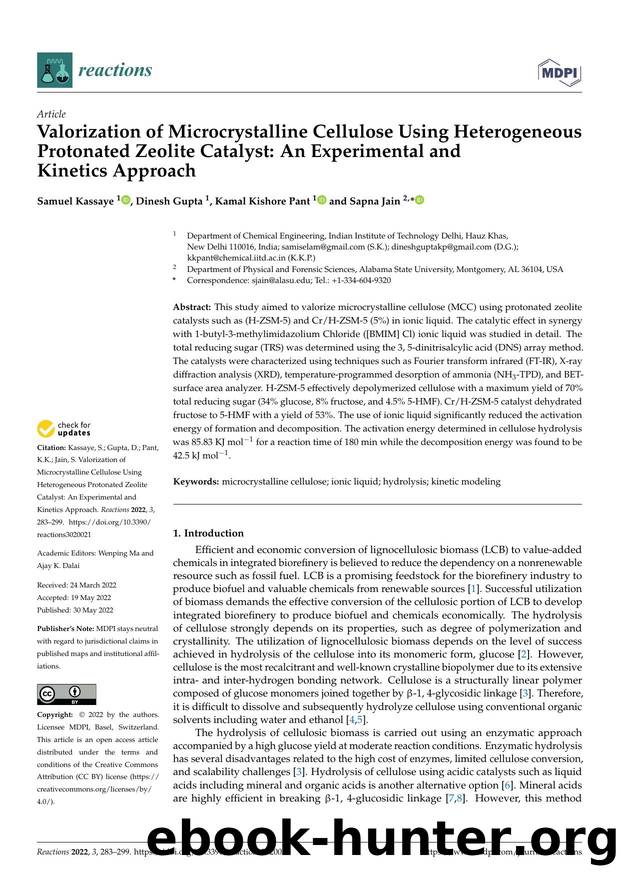Valorization of Microcrystalline Cellulose Using Heterogeneous Protonated Zeolite Catalyst: An Experimental and Kinetics Approach by Samuel Kassaye Dinesh Gupta Kamal Kishore Pant & Sapna Jain

Author:Samuel Kassaye, Dinesh Gupta, Kamal Kishore Pant & Sapna Jain
Format: pdf
Tags: This study aimed to valorize microcrystalline cellulose (MCC) using protonated zeolite catalysts such as (H-ZSM-5) and Cr/H-ZSM-5 (5%) in ionic liquid. The catalytic effect in synergy with 1-butyl-3-methylimidazolium Chloride ([BMIM] Cl) ionic liquid was studied in detail. The total reducing sugar (TRS) was determined using the 3, 5-dinitrisalcylic acid (DNS) array method. The catalysts were characterized using techniques such as Fourier transform infrared (FT-IR), X-ray diffraction analysis (XRD), temperature-programmed desorption of ammonia (NH3-TPD), and BET-surface area analyzer. H-ZSM-5 effectively depolymerized cellulose with a maximum yield of 70% total reducing sugar (34% glucose, 8% fructose, and 4.5% 5-HMF). Cr/H-ZSM-5 catalyst dehydrated fructose to 5-HMF with a yield of 53%. The use of ionic liquid significantly reduced the activation energy of formation and decomposition. The activation energy determined in cellulose hydrolysis was 85.83 KJ mol-1 for a reaction time of 180 min while the decomposition energy was found to be 42.5 kJ mol-1., microcrystalline cellulose; ionic liquid; hydrolysis; kinetic modeling
Download
This site does not store any files on its server. We only index and link to content provided by other sites. Please contact the content providers to delete copyright contents if any and email us, we'll remove relevant links or contents immediately.
What's Done in Darkness by Kayla Perrin(25507)
Shot Through the Heart: DI Grace Fisher 2 by Isabelle Grey(18227)
Shot Through the Heart by Mercy Celeste(18169)
The Fifty Shades Trilogy & Grey by E L James(17783)
The 3rd Cycle of the Betrayed Series Collection: Extremely Controversial Historical Thrillers (Betrayed Series Boxed set) by McCray Carolyn(13197)
The Subtle Art of Not Giving a F*ck by Mark Manson(12925)
Scorched Earth by Nick Kyme(11843)
Stepbrother Stories 2 - 21 Taboo Story Collection (Brother Sister Stepbrother Stepsister Taboo Pseudo Incest Family Virgin Creampie Pregnant Forced Pregnancy Breeding) by Roxi Harding(11062)
Drei Generationen auf dem Jakobsweg by Stein Pia(10223)
Suna by Ziefle Pia(10188)
Scythe by Neal Shusterman(9271)
International Relations from the Global South; Worlds of Difference; First Edition by Arlene B. Tickner & Karen Smith(8625)
Successful Proposal Strategies for Small Businesses: Using Knowledge Management ot Win Govenment, Private Sector, and International Contracts 3rd Edition by Robert Frey(8426)
This is Going to Hurt by Adam Kay(7713)
Dirty Filthy Fix: A Fixed Trilogy Novella by Laurelin Paige(6461)
He Loves Me...KNOT by RC Boldt(5809)
How to Make Love to a Negro Without Getting Tired by Dany LaFerrière(5390)
Interdimensional Brothel by F4U(5312)
Thankful For Her by Alexa Riley(5174)
